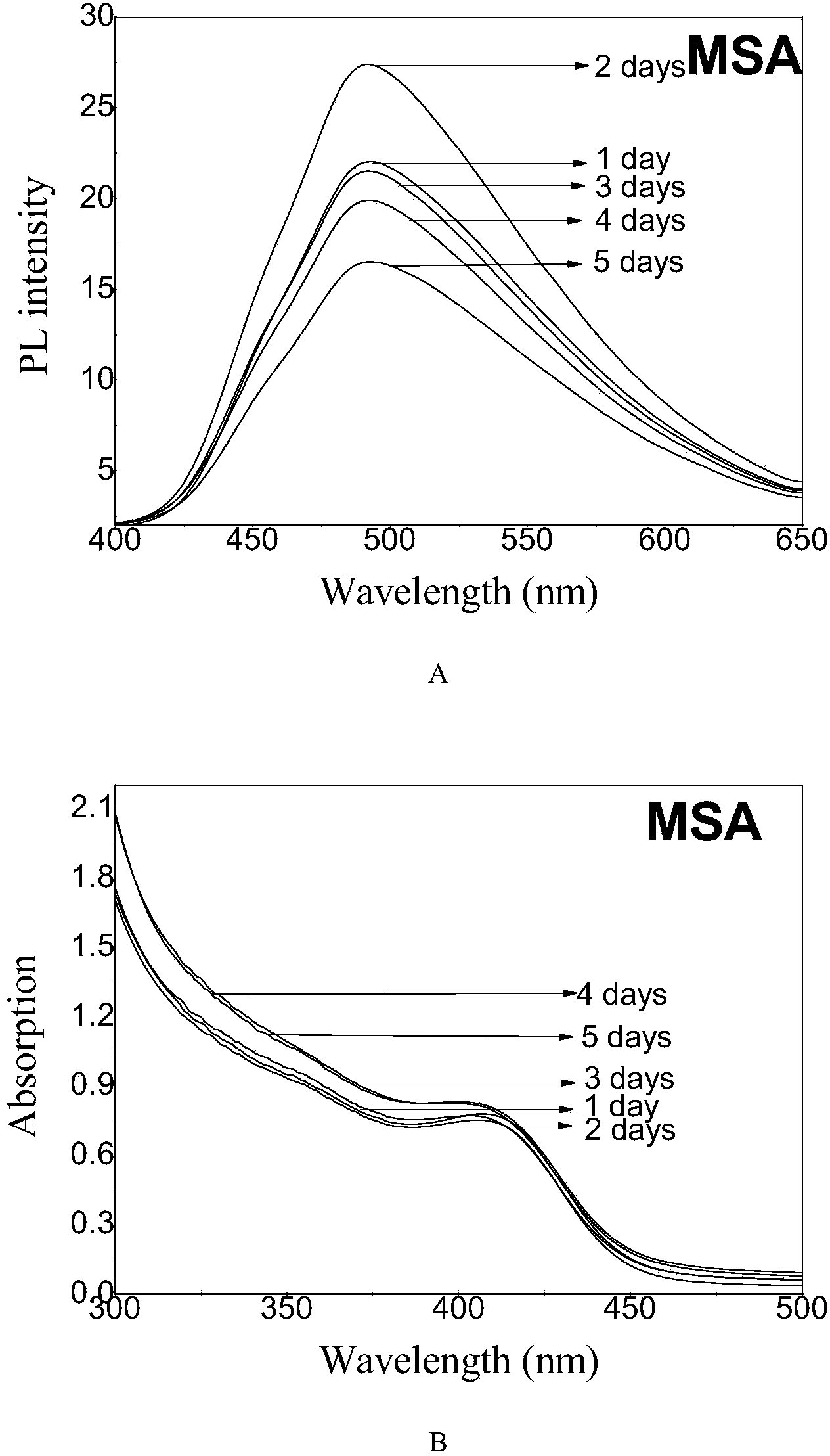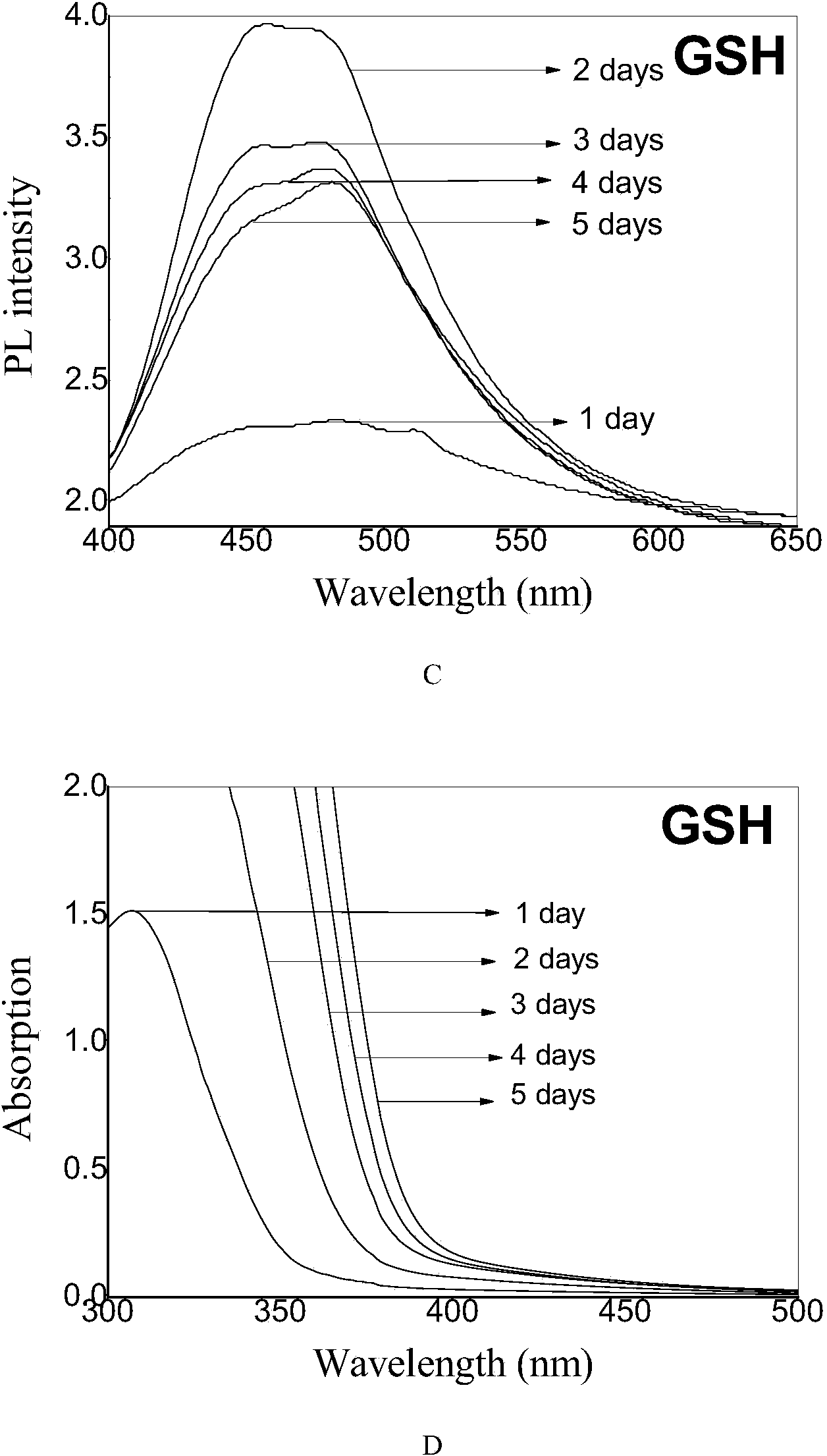Biosynthesis method of cadmium selenide quantum dots
A technology of biosynthesis and quantum dots, which is applied in the field of biosynthesis of cadmium selenide quantum dots, can solve the problems of limiting the application of quantum dots and the troubles of quantum dots, and achieves the effect of convenient operation, low cost and good biocompatibility
- Summary
- Abstract
- Description
- Claims
- Application Information
AI Technical Summary
Problems solved by technology
Method used
Image
Examples
Embodiment 1
[0025] Escherichia coli (E.coli K12 (DH10B), provided by Beijing Dingguo Changsheng Biotechnology Co., Ltd.) was inoculated into LB medium and cultured at 37°C until OD 600 = 0.6, the seed solution was obtained, which was centrifuged, and the supernatant was removed to obtain wet cells of Escherichia coli. Take 1ml of Escherichia coli wet bacteria and inoculate it into M9 medium, and cultivate it to OD at 37°C 600 =0.6, the second-generation Escherichia coli wet cells were obtained for the preparation of quantum dots.
[0026] LB medium (500ml): 2.5g of yeast extract, 5g of peptone, 5g of sodium chloride, adjust the pH to about 7.0 with NaOH, and the solvent is water.
[0027]M9 medium (500ml): disodium hydrogen phosphate 15g, potassium dihydrogen phosphate 7.5g, ammonium chloride 2.5g, sodium chloride 1.25g, 1ml (1mol / L) magnesium sulfate heptahydrate aqueous solution, glucose 2g / L, pH Naturally, the solvent is water.
[0028] Take 0.015g of the second-generation Escherich...
Embodiment 2
[0035] Yeast (Saccharomyces cerevisiae (S288C), provided by Beijing Dingguo Changsheng Biotechnology Co., Ltd.) was inoculated into YPD medium and cultured at 37°C until OD 600 = 0.6, to obtain the seed liquid, centrifuge it, remove the supernatant, and obtain the wet yeast cell, take 1ml of the wet yeast cell and inoculate it into the Chapei medium, and continue to cultivate at 37°C until OD 600 =0.6, the second-generation yeast wet cells were obtained for the preparation of quantum dots.
[0036] YPD medium (500ml): 5g of yeast extract, 10g of peptone, 10g of glucose, adjust the pH to about 7.0 with NaOH, and the solvent is water;
[0037] Cha's medium (500ml): 15g of sucrose, 1g of sodium nitrate, 0.5g of dipotassium phosphate, 0.25g of potassium chloride, 0.25g of magnesium sulfate heptahydrate, adjust the pH to about 7.0 with NaOH, and the solvent is water.
[0038] Take 0.015g of the second-generation yeast wet thallus, transfer it into a single-necked flask, add it to ...
Embodiment 3
[0045] (1) The disposition method of Escherichia coli wet thalline is as described in embodiment 1, gets 0.0015g second generation Escherichia coli wet thalline and moves in a single-necked flask, joins the M9 substratum of 45ml (composition is the same as embodiment 1) , then add 4ml of 0.04mol·l under continuous stirring -1 CdCl 2 Aqueous solution, 400mg trisodium citrate dihydrate, 40mg MSA, 1.5ml0.01mol·l -1 Na 2 SeO 3 Aqueous solution, cultivated at 37°C for 5 days, filtered, discarded the precipitate, added an equal volume of absolute ethanol to the supernatant, centrifuged to obtain CdSe quantum dots, dried in a vacuum oven, and dried CdSe quantum dots High-resolution transmission electron microscopy imaging ( Figure 4 shown), infrared imaging ( Figure 5 shown).
[0046] (2) Escherichia coli is inoculated to the M9 medium (the culture method is the same as embodiment 1) by the wet thalli after LB medium seed culture, obtains the nutrient solution containing Esch...
PUM
| Property | Measurement | Unit |
|---|---|---|
| diameter | aaaaa | aaaaa |
| particle diameter | aaaaa | aaaaa |
Abstract
Description
Claims
Application Information
 Login to View More
Login to View More - Generate Ideas
- Intellectual Property
- Life Sciences
- Materials
- Tech Scout
- Unparalleled Data Quality
- Higher Quality Content
- 60% Fewer Hallucinations
Browse by: Latest US Patents, China's latest patents, Technical Efficacy Thesaurus, Application Domain, Technology Topic, Popular Technical Reports.
© 2025 PatSnap. All rights reserved.Legal|Privacy policy|Modern Slavery Act Transparency Statement|Sitemap|About US| Contact US: help@patsnap.com



